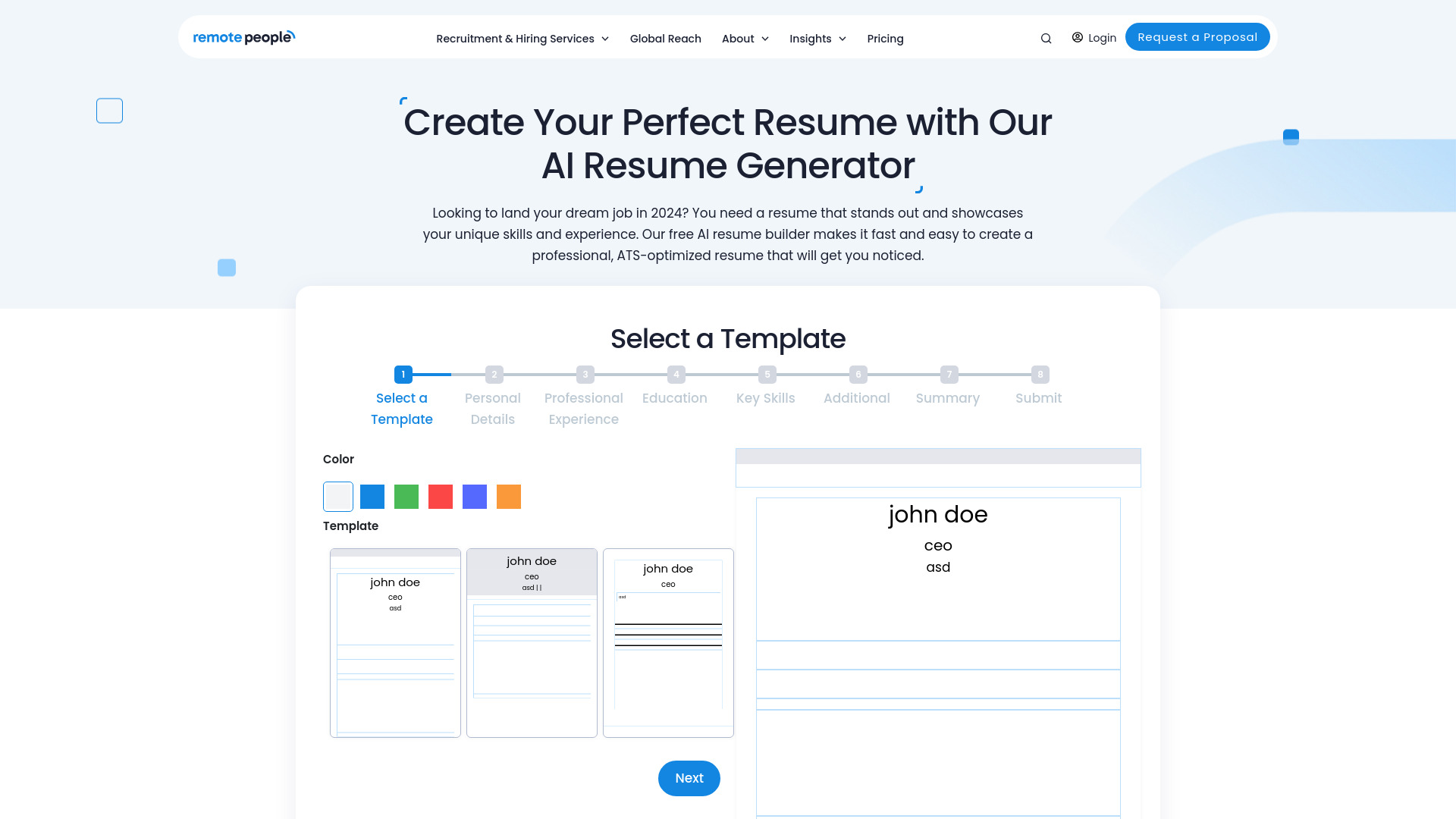- Home
- AI Writing Assistants
- Remote People

Remote People
Open Website-
Tool Introduction:Remote People AI hires global talent, slashes HR/payroll with EOR.
-
Inclusion Date:Oct 28, 2025
-
Social Media & Email:
Tool Information
What is Remote People AI
Remote People AI is a global recruitment and HR platform that helps companies find top talent and manage remote teams across 150+ countries. It unifies international recruitment and executive search with employer of record (EOR), global payroll, contractor payments, and automated background checks. By combining AI-assisted candidate matching, compliant hiring, and multi-currency payroll, the platform reduces HR and payroll costs while minimizing compliance risk. Businesses can enter new markets without local entities, streamline onboarding, and scale distributed teams with one consolidated workflow.
Remote People AI Main Features
- AI-assisted talent sourcing: Match role requirements to qualified candidates globally, prioritize fit, and accelerate time-to-hire.
- International recruitment & executive search: End-to-end sourcing, screening, and offer management for specialist and leadership roles.
- Employer of Record (EOR): Hire compliantly without setting up local entities; issue localized contracts, benefits, and statutory contributions.
- Global payroll & payments: Run multi-country payroll, automate tax and social filings, and pay employees and contractors in multiple currencies.
- Compliance automation: Handle labor law, misclassification checks, and documentation to reduce regulatory risk.
- Background checks: Verify identity, employment history, education, and criminal records where permitted.
- Onboarding & document management: Streamline contract generation, e-signatures, and secure document storage.
- Analytics & reporting: Track hiring funnel metrics, payroll costs, and headcount across countries.
- 150+ country coverage: Access localized hiring, payroll rules, and benefits administration at global scale.
Who Should Use Remote People AI
Remote People AI is ideal for startups, scale-ups, and enterprises expanding internationally; HR and People Ops teams managing distributed workforces; founders hiring their first overseas employees; finance leaders consolidating multi-country payroll; and organizations needing compliant EOR hiring, executive search, contractor management, and background screening for remote or hybrid teams.
How to Use Remote People AI
- Create an account or request a demo to assess country coverage and service options.
- Define hiring goals: roles, seniority, target countries, contract type (employee vs contractor), and timeline.
- Select services: recruitment/executive search, EOR employment, global payroll, and background checks as needed.
- Publish the role profile; leverage AI-assisted sourcing and screening to shortlist candidates.
- Run interviews and assessments; coordinate offers with localized compensation guidance.
- For EOR hires, generate compliant contracts, benefits, and policies aligned with local law.
- Initiate background checks with candidate consent and review the results securely.
- Onboard new hires: collect documents, set pay cycles, benefits, and expense policies.
- Process monthly payroll and cross-border payments; reconcile taxes and contributions.
- Monitor analytics on hiring velocity, cost per hire, payroll spend, and headcount.
Remote People AI Industry Use Cases
A SaaS startup entering LATAM uses EOR to hire its first sales team and runs global payroll from a single dashboard. A fintech scales into Europe through executive search for a Compliance Director, pairing it with local payroll and benefits setup. A creative agency converts contractors to compliant employment in APAC, reducing misclassification risk. A biotech builds a remote data team across three countries, using background checks and consolidated multi-currency payments to ensure secure, timely payroll.
Remote People AI Pricing
Pricing is typically quote-based and depends on country, headcount, and selected services. Common models include per-employee monthly fees for EOR, per-employee or per-country fees for global payroll, and contingency or retained fees for recruitment and executive search. Background checks are often priced per candidate. Contact sales for a tailored proposal based on your locations and hiring plan.
Remote People AI Pros and Cons
Pros:
- End-to-end solution spanning recruitment, EOR, payroll, and background checks.
- Compliance-first approach that reduces legal and misclassification risk.
- 150+ country coverage enables rapid market entry without local entities.
- Consolidated payroll and payments improve cost control and visibility.
- AI-assisted matching shortens time-to-hire and improves candidate fit.
Cons:
- Per-employee EOR and payroll fees can add up for very large teams.
- Country-specific rules may limit benefits or contract flexibility in some markets.
- Onboarding timelines can vary depending on local compliance requirements.
- Dependence on third-party local partners may affect SLA consistency by region.
Remote People AI FAQs
-
Q1: What is the difference between EOR and traditional hiring?
EOR lets you employ staff in a country without creating a local entity. The EOR is the legal employer, handling contracts, payroll, and compliance while you manage day-to-day work.
-
Q2: Can Remote People AI pay contractors as well as employees?
Yes, it supports cross-border contractor payments alongside employee payroll, with tools to minimize misclassification risk.
-
Q3: How does background checking work?
With candidate consent, the platform runs checks such as identity, employment history, education, and criminal records where legally permitted, then provides a consolidated report.
-
Q4: Which countries are supported?
Coverage spans 150+ countries; availability of specific services (EOR, payroll, benefits) varies by jurisdiction. Confirm your target countries during scoping.
-
Q5: How long does global hiring take?
Timelines depend on role seniority, market, and compliance steps. Recruitment can range from weeks to months; EOR onboarding is typically faster once documentation is complete.
